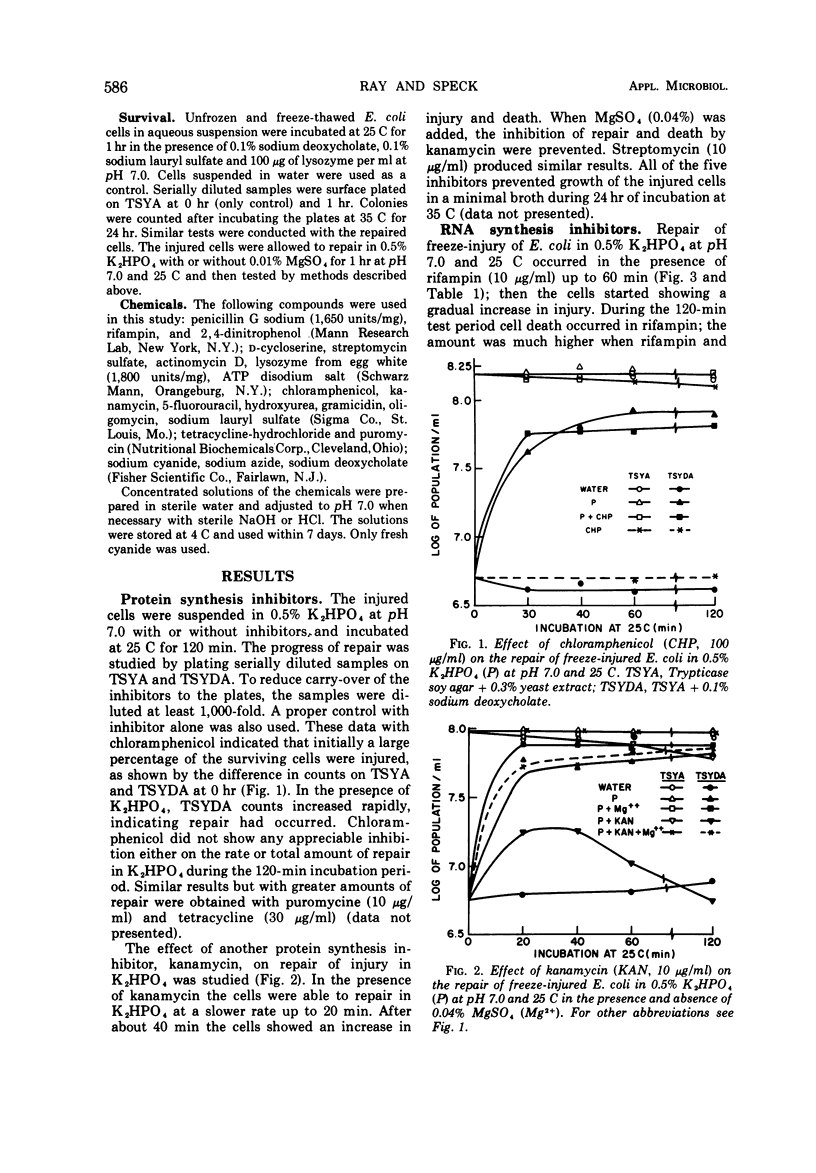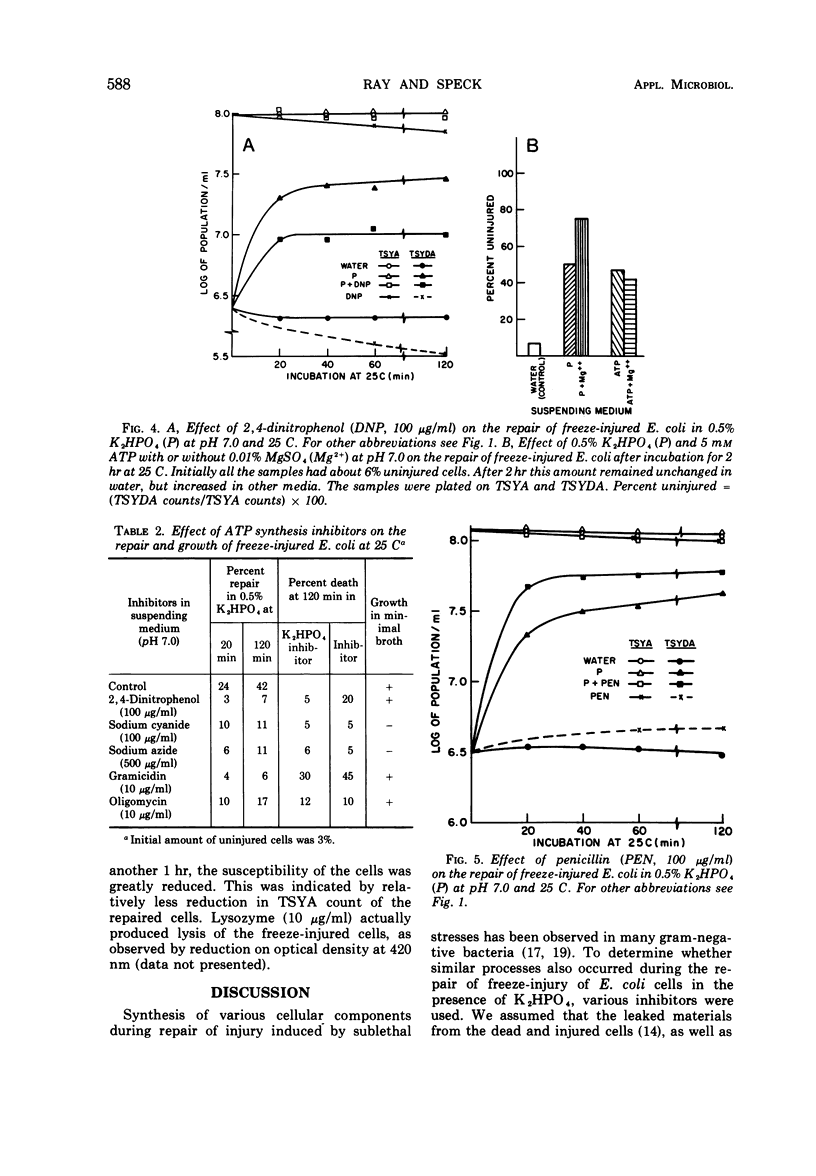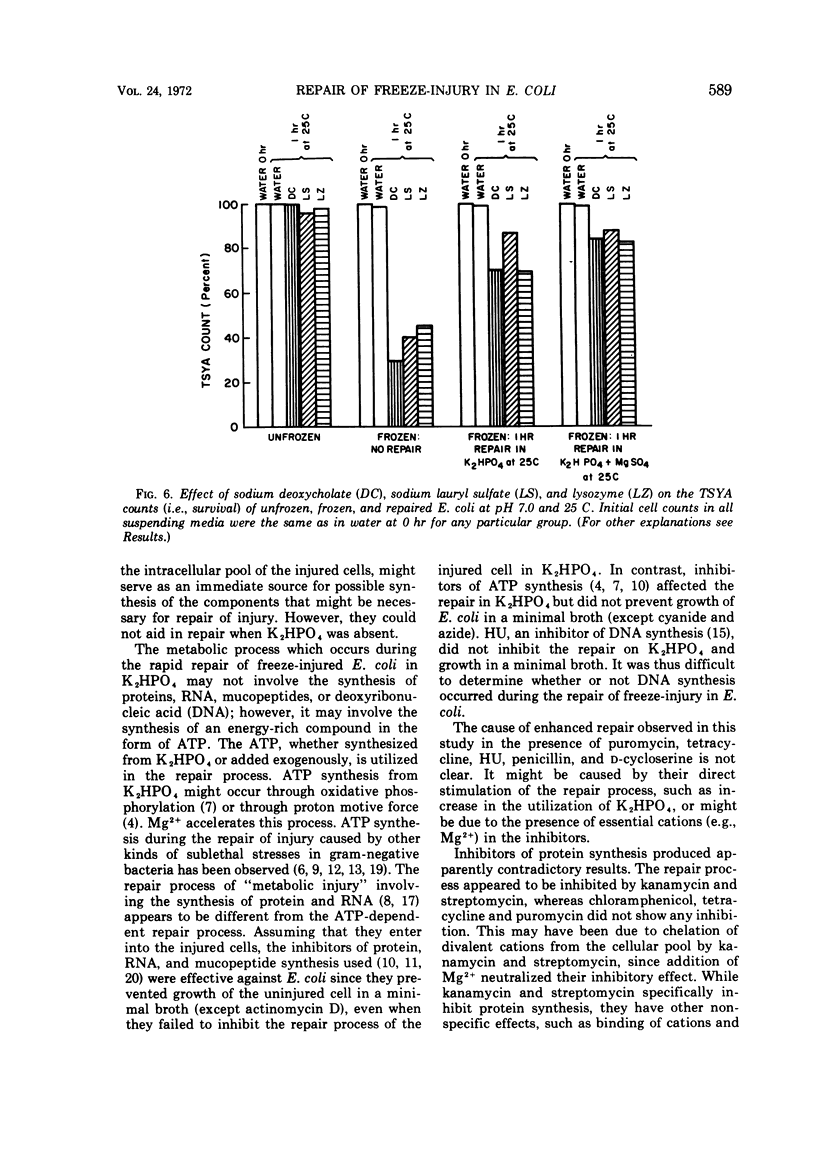Abstract
After Escherichia coli was injured by freezing, the repair process was studied during incubation of the cells for 2 hr at 25 C in 0.5% K2HPO4 at pH 7.0 in the presence of specific metabolic inhibitors. The repair in K2HPO4 was not affected by inhibitors of the synthesis of protein, nucleic acids, and mucopeptide. These inhibitors prevented growth of the repaired cells in a minimal broth at 35 C for 24 hr (except actinomycin D and hydroxyurea). Several uncouplers of adenosine triphosphate (ATP) synthesis reduced the repair process in K2HPO4, but only cyanide and azide prevented growth in minimal medium. Data indicated that the cells synthesized energy in the form of ATP and probably utilized it for the repair process. Addition of ATP also facilitated the repair of injury. The freeze-injured cells showed extreme susceptibility to surface-active agents and lysozyme. The repaired cells, like the uninjured cells, became relatively resistant to these compounds.
Full text
PDF





Selected References
These references are in PubMed. This may not be the complete list of references from this article.
- Bretz H. W., Kocka F. E. Resistance to actinomycin D of Escherichia coli after frozen storage. Can J Microbiol. 1967 Jul;13(7):914–917. doi: 10.1139/m67-121. [DOI] [PubMed] [Google Scholar]
- Glauert A. M., Thornley M. J. The topography of the bacterial cell wall. Annu Rev Microbiol. 1969;23:159–198. doi: 10.1146/annurev.mi.23.100169.001111. [DOI] [PubMed] [Google Scholar]
- Gray G. W., Wilkinson S. G. The effect of ethylenediaminetetra-acetic acid on the cell walls of some gram-negative bacteria. J Gen Microbiol. 1965 Jun;39(3):385–399. doi: 10.1099/00221287-39-3-385. [DOI] [PubMed] [Google Scholar]
- Henderson P. J. Ion transport by energy-conserving biological membranes. Annu Rev Microbiol. 1971;25:393–428. doi: 10.1146/annurev.mi.25.100171.002141. [DOI] [PubMed] [Google Scholar]
- KOHN A. Lysis of frozen and thawed cells of Escherichia coli by lysozyme and their conversion into spheroplasts. J Bacteriol. 1960 May;79:697–706. doi: 10.1128/jb.79.5.697-706.1960. [DOI] [PMC free article] [PubMed] [Google Scholar]
- Leive L. Studies on the permeability change produced in coliform bacteria by ethylenediaminetetraacetate. J Biol Chem. 1968 May 10;243(9):2373–2380. [PubMed] [Google Scholar]
- Moss C. W., Speck M. L. Identification of nutritional components in trypticase responsible for recovery of Escherichia coli injured by freezing. J Bacteriol. 1966 Mar;91(3):1098–1104. doi: 10.1128/jb.91.3.1098-1104.1966. [DOI] [PMC free article] [PubMed] [Google Scholar]
- Mullinix K. P., Rosenkranz H. S. Recovery from N-hydroxyurethan-induced death. J Bacteriol. 1971 Feb;105(2):565–572. doi: 10.1128/jb.105.2.565-572.1971. [DOI] [PMC free article] [PubMed] [Google Scholar]
- Newton B. A. Mechanisms of antibiotic action. Annu Rev Microbiol. 1965;19:209–240. doi: 10.1146/annurev.mi.19.100165.001233. [DOI] [PubMed] [Google Scholar]
- Pestka S. Inhibitors of ribosome functions. Annu Rev Microbiol. 1971;25:487–562. doi: 10.1146/annurev.mi.25.100171.002415. [DOI] [PubMed] [Google Scholar]
- ROSENKRANZ H. S., LEVY J. A. HYDROXYUREA: A SPECIFIC INHIBITOR OF DEOXYRIBONUCLEIC ACID SYNTHESIS. Biochim Biophys Acta. 1965 Jan 11;95:181–183. doi: 10.1016/0005-2787(65)90225-x. [DOI] [PubMed] [Google Scholar]
- Ray B., Janssen D. W., Busta F. F. Characterization of the repair of injury induced by freezing Salmonella anatum. Appl Microbiol. 1972 Apr;23(4):803–809. doi: 10.1128/am.23.4.803-809.1972. [DOI] [PMC free article] [PubMed] [Google Scholar]
- Ray B., Jezeski J. J., Busta F. F. Repair of injury in freeze-dried Salmonella anatum. Appl Microbiol. 1971 Sep;22(3):401–407. doi: 10.1128/am.22.3.401-407.1971. [DOI] [PMC free article] [PubMed] [Google Scholar]
- Ray B., Speck M. L. Repair of injury induced by freezing Escherichia coli as influenced by recovery medium. Appl Microbiol. 1972 Aug;24(2):258–263. doi: 10.1128/am.24.2.258-263.1972. [DOI] [PMC free article] [PubMed] [Google Scholar]
- STRANGE R. E., POSTGATE J. R. PENETRATION OF SUBSTANCES INTO COLD-SHOCKED BACTERIA. J Gen Microbiol. 1964 Sep;36:393–403. doi: 10.1099/00221287-36-3-393. [DOI] [PubMed] [Google Scholar]
- Scheusner D. L., Busta F. F., Speck M. L. Inhibition of injured Escherichia coli by several selective agents. Appl Microbiol. 1971 Jan;21(1):46–49. doi: 10.1128/am.21.1.46-49.1971. [DOI] [PMC free article] [PubMed] [Google Scholar]
- Sinskey T. J., Silverman G. J. Characterization of injury incurred by Escherichia coli upon freeze-drying. J Bacteriol. 1970 Feb;101(2):429–437. doi: 10.1128/jb.101.2.429-437.1970. [DOI] [PMC free article] [PubMed] [Google Scholar]
- Tomlins R. I., Ordal Z. J. Requirements of Salmonella typhimurium for recovery from thermal injury. J Bacteriol. 1971 Feb;105(2):512–518. doi: 10.1128/jb.105.2.512-518.1971. [DOI] [PMC free article] [PubMed] [Google Scholar]
- Wehrli W., Staehelin M. Actions of the rifamycins. Bacteriol Rev. 1971 Sep;35(3):290–309. doi: 10.1128/br.35.3.290-309.1971. [DOI] [PMC free article] [PubMed] [Google Scholar]


